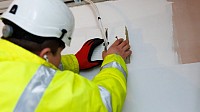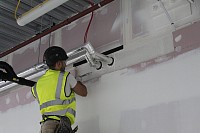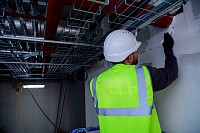Fire Stopping Installation - An Introduction
The importance of effective fire stopping installation in modern architecture cannot be overstated. With the increasing complexity of building designs and materials, ensuring fire safety through proper compartmentation is essential. As fires can spread rapidly through hidden spaces, implementing cavity fire barrier solutions has become crucial. These barriers not only prevent the movement of smoke and flames but also help protect structural integrity, giving occupants vital time to evacuate. Understanding how these solutions have evolved is key to appreciating their role in contemporary safety measures within buildings. Historically, fire safety measures focused primarily on active systems, such as sprinklers and alarms. However, there has been a significant shift towards passive fire stopping solutions that provide continuous protection. Fire stopping companies now offer a variety of options designed to work seamlessly with architectural designs. Cavity wall fire safety systems have emerged as effective methods to compartmentalize spaces, allowing for safer buildings. By integrating these systems into new constructions, architects and builders can better safeguard lives while adhering to stringent building codes.
The introduction of fire-resistant cavity barriers has revolutionized how fire compartmentation is approached. These barriers are engineered to withstand high temperatures and block the spread of fire, creating effective fire compartments. As fire compartmentation services continue to advance, they now encompass a wider range of applications, including cavity fire barriers for commercial buildings. The focus has shifted from merely complying with safety regulations to actively enhancing fire safety through innovative design and materials. As a result, the performance and reliability of these systems have improved significantly. In the realm of firestop protection, various materials and technologies have been developed to address specific fire risks. These advancements include intumescent paints, sealants, and specialized barrier materials that expand under heat, sealing off openings. Such innovations enable effective compartmentation fire safety systems that are adaptable to different building types and layouts. Furthermore, fire compartmentation solutions for buildings can now be tailored to meet unique safety needs, ensuring comprehensive coverage against potential fire hazards. This flexibility makes it easier for architects and builders to integrate these solutions into their designs.
The role of fire compartmentation contractors has also evolved in this landscape. These professionals are now required to possess a deeper understanding of fire safety principles and the latest technologies. They must be familiar with various installation techniques and able to implement fire stopping installation that meets or exceeds industry standards. Collaboration between architects, builders, and contractors ensures that fire safety measures are not an afterthought but an integral part of the construction process. This collaborative approach fosters a culture of safety and accountability in modern architecture. As the focus on fire safety continues to grow, the evolution of cavity fire barrier solutions is likely to progress further. Innovations will emerge to address new challenges posed by modern building designs and materials. Increased awareness of fire risks will drive the demand for effective fire compartmentation solutions that provide long-lasting protection. The future of fire safety in architecture will hinge on the seamless integration of passive fire stopping systems, emphasizing prevention and safety. Ultimately, these hidden protectors play a critical role in ensuring the safety and well-being of occupants in an increasingly complex built environment.
Important Things About Fire Stopping Companies
In the construction industry, ensuring fire safety is crucial, particularly when it comes to fire stopping installation. This process involves creating fire-resistant barriers within a building to slow the spread of flames and smoke, protecting occupants and property. Various fire stopping companies specialize in implementing these measures, adhering to local building codes and safety regulations. The effectiveness of fire safety measures hinges on the proper installation of these barriers, which necessitates thorough planning and coordination among different stakeholders involved in the construction process. The concept of passive fire stopping focuses on constructing barriers that do not require active intervention during a fire. These barriers are designed to compartmentalize a building, providing designated safe zones for occupants to evacuate. Cavity fire barrier solutions play a pivotal role in this strategy, as they can fill the voids and gaps between walls, floors, and ceilings. By utilizing cavity wall fire safety systems, buildings can enhance their overall fire resistance, significantly reducing the risk of rapid fire spread. This proactive approach helps in safeguarding lives while also preserving the structural integrity of the building.
Understanding the various types of fire-resistant cavity barriers is essential for effective fire compartmentation. These barriers are manufactured from materials engineered to withstand high temperatures and prevent flames from penetrating through walls. Implementing fire compartmentation services is vital for commercial buildings, as they often have complex layouts and numerous occupants. By using these solutions, property owners can ensure that their buildings meet the required safety standards. Additionally, specialized fire compartmentation solutions for buildings allow for customization based on specific needs and challenges, further enhancing safety measures. When seeking effective firestop protection, it is important to work with qualified fire compartmentation contractors who possess the necessary expertise and training. These professionals are responsible for evaluating the building's design and identifying areas that require fire stopping measures. They should be well-versed in the latest fire safety codes and technologies, ensuring that installations comply with industry standards. A collaborative effort between contractors, architects, and builders is essential for achieving comprehensive fire safety within a structure, as each party brings valuable insights to the table.
Moreover, the installation of fire stopping solutions requires ongoing maintenance and inspection to ensure they remain effective over time. Regular checks can help identify any wear or damage that could compromise the fire barriers. Property owners should prioritize routine evaluations of their compartmentation fire safety systems to uphold safety standards. This commitment to maintenance reflects a proactive approach to fire safety, ensuring that the measures in place are always functioning at peak efficiency. In summary, implementing fire stopping installation is a critical aspect of modern building design. By utilizing fire stopping companies and engaging knowledgeable fire compartmentation contractors, property owners can effectively integrate passive fire stopping solutions into their structures. The evolution of cavity fire barrier solutions continues to enhance fire safety in both residential and commercial buildings, emphasizing the importance of thorough planning and execution. As the construction industry evolves, maintaining a strong focus on fire safety through effective compartmentation practices will remain essential in safeguarding lives and property alike.
Deeper Look On Passive Fire Stopping
Fire safety is a crucial aspect of building design and construction, particularly in commercial settings where large numbers of people gather. Effective fire stopping installation is essential for preventing the spread of fire and smoke, safeguarding occupants and property. A well-planned fire stopping system involves the strategic placement of barriers that seal off openings and joints, creating safe compartments within a structure. Various fire stopping companies offer specialized services to implement these measures, ensuring that buildings comply with safety regulations while enhancing their overall resilience against fire hazards. One of the key strategies in fire safety is passive fire stopping, which relies on building materials and design features to contain fires without requiring active intervention. This method is critical in minimizing damage and allowing for safer evacuations. Cavity fire barrier solutions are integral to this approach, filling gaps between walls, ceilings, and floors. These barriers effectively prevent flames from moving between compartments, providing crucial time for occupants to exit the building. Check out the following site, if you are searching for more information regarding passive fire stopping.
Integrating cavity wall fire safety systems into the design can significantly enhance the fire-resistance of commercial buildings. Cavity fire barriers for commercial buildings are designed to withstand extreme temperatures and maintain their integrity during a fire. By utilizing fire-resistant cavity barriers, property owners can ensure that their structures are equipped to handle fire-related emergencies. These barriers act as a shield, effectively containing fires and minimizing their impact. Implementing fire compartmentation services is essential for creating safe zones within buildings, allowing for effective evacuation routes and reducing the overall risk to life and property. To achieve optimal firestop protection, it is important to work with experienced fire compartmentation contractors. These professionals are trained in the latest fire safety techniques and understand the complexities of building codes and regulations. Their expertise allows them to assess the unique needs of each project and recommend appropriate fire compartmentation solutions for buildings. A collaborative effort among architects, builders, and contractors ensures that fire safety measures are seamlessly integrated into the design and construction process, resulting in comprehensive protection.
Maintaining effective fire safety measures requires regular inspection and maintenance of the installed systems. Routine evaluations help identify any potential weaknesses or areas of concern, ensuring that the compartmentation fire safety systems continue to function optimally over time. Property owners should prioritize these assessments, as a proactive approach can significantly reduce the risks associated with fire hazards. By keeping the fire stopping systems in good condition, buildings can remain safe and compliant with evolving fire safety standards. In summary, the importance of effective fire stopping installation cannot be overstated in the context of commercial buildings. By leveraging the expertise of qualified fire stopping companies and engaging skilled fire compartmentation contractors, property owners can implement robust fire safety measures that include passive fire stopping techniques and cavity fire barrier solutions. Investing in these systems not only protects lives but also preserves property value and enhances the overall safety of commercial environments. As regulations evolve, maintaining a commitment to fire safety will continue to be essential in the construction industry, ensuring that buildings are equipped to withstand fire emergencies.



